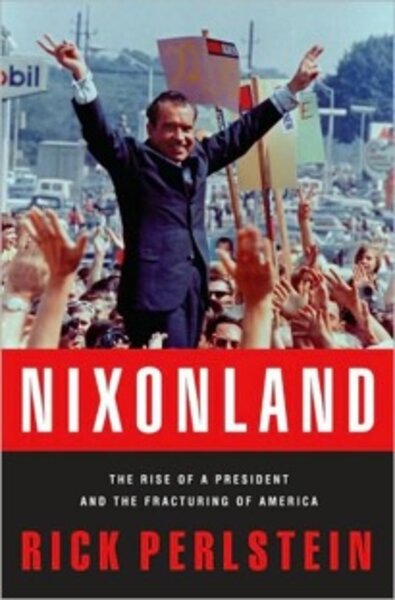Nixon: a life divided
Loading...
A few years can make a big difference in the life of a nation. In 1964, Lyndon Johnson was elected president in a landslide so definitive that political observers saw it as the emergence of “a liberal national consensus” or, as Johnson himself said later that year when lighting the White House Christmas tree, “These are the most hopeful times since Christ was born in Bethlehem.”
Yet just eight years later, the Democratic Party was in a complete shambles and Richard Nixon won 49 states. Some consensus.
How this happened, according to Rick Perlstein’s Nixonland, is largely the story of Richard Nixon and his ability to identify the resentments of middle-class Americans, articulate them, and turn them into votes.
Nixon’s penchant for defining issues as “us” against “them” started when he was an undergraduate at Whittier College and sought to join a “circle of swells” called the “Franklins.” He was rebuffed and started his own group made up of young people like himself – quiet, hardworking strivers. He named the club “The Orthogonians,” and told its members that they were “upright” and “straight shooters.”
Perlstein says that this mind-set stayed with Nixon (“a serial collector of resentments”) throughout his life and was the essence of his worldview. Indeed, whenever Nixon faced a crisis, as in his 1952 “Checkers” speech, he portrayed himself as a scrappy underdog battling against elites and privilege.
The ’60s, of course, were about much more than Richard Nixon: Vietnam, urban riots, campus disturbances, social upheaval, civil rights battles, and political assassinations were commonplace. According to Perlstein, middle-class Americans reacted to these developments with resentment and fear, and Nixon succeeded politically because he convinced what came to be called “The Silent Majority” that he understood and shared their concerns.
This is, of course, a complicated, multifaceted story and Perlstein marshals impressive organization skills to incorporate it into a coherent narrative.
The central themes of the story are the struggle for civil rights and the Vietnam conflict. In describing the civil rights movement, Perlstein spends considerable time documenting the unconcealed hatred and racism that characterized the era and the reader is reminded how far we have come as a nation. But in retelling the story of the Vietnam War, he describes the colossal mistakes made in Southeast Asia and the reader cannot avoid thinking of the Iraq war and realizing how little we have learned.
This sprawling, complex, well-written book is jampacked with ideas and insights that will capture any reader’s attention. But the central lesson Perlstein draws from the ’60s is that they still drive American politics. In his words: “What Richard Nixon left behind was the ... notion that there are two kinds
of Americans. On one side, that ‘Silent Majority.’ ... The middle-class, middle American, suburban, exurban, and rural coalitions who call themselves, now, ‘Values voters,’ ‘people of faith,’ ‘patriots,’ or even simply, ‘Republicans....’ On the other side are ‘liberals,’ ‘the cosmopolitans,’ ‘the intellectuals,’ ‘the professionals’ – ‘Democrats....’ who look down on the first category as unwitting dupes of feckless elites who exploit sentimental pieties to aggrandize their wealth, start wars, ruin lives.”
In short, to Perlstein, the story of Richard Nixon in the 1960s and early 1970s is the story of modern American politics. In this case, I think he goes too far. Nixon was not the central figure that Perlstein implies during the Johnson presidency. Nixon worked hard to become the Republican nominee in 1968 but he was not directing events – like the urban unrest and campus disturbances – that helped his political reemergence.
The secret of his success was figuring out how to turn these developments and the fears they revealed into a political agenda. But for all his insight and skill, luck played a huge role in his reemergence as a national political figure.
And after he left the stage in August 1974, Nixon was hardly a popular figure. It would be easier to make a case that it was Ronald Reagan, the actor-turned-politician, whose legacy has defined modern American politics.
But despite overstating Nixon’s legacy, this is a wonderful book. Perlstein spent seven years researching the volume and the hard work shows: It is extensively researched and offers fresh and interesting perspectives at every turn.
Better editing could have shortened it, caught the typographical errors and eliminated some of the clichés. (He actually writes “Something was happening here. What it was wasn’t exactly clear.”) Better fact checking would have eliminated some of the errors that have crept into the text. (US Sen. Hugh Scott was from Pennsylvania, not Ohio; Congressman Wayne Hays did not represent Cleveland; Sen. Robert Byrd was not the chairman of the Senate appropriations committee in 1968; and no “hippies” were “beat to death” with pool cues at the Altamont Rock Festival.)
But “Nixonland” is a fascinating book that reads like a novel. Whether readers lived through the ’60s or not, they will be gripped from start to finish.






